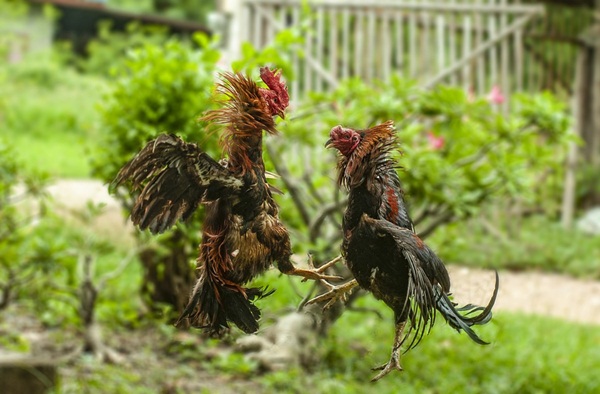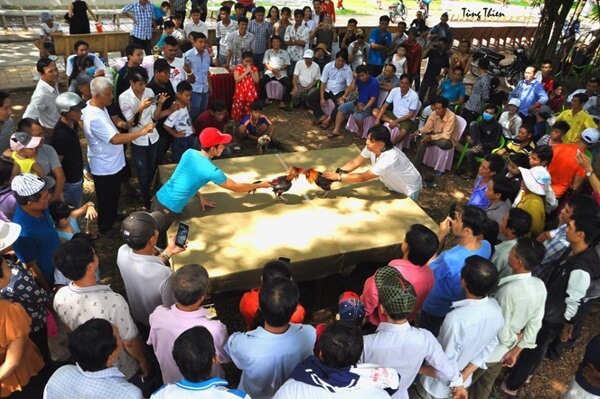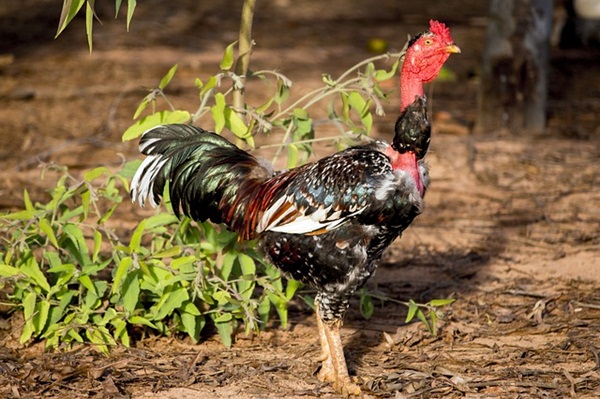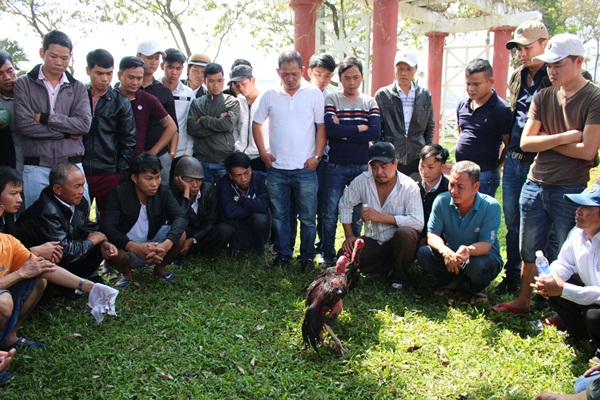In Vietnam, cockfighting is more than a contest—it’s a centuries-old pastime rooted in skill, tradition, and community spirit. Once considered an elegant hobby, it symbolized chivalry and encouraged the breeding of strong, healthy roosters.
During village festivals, the lively sound of cheering often draws visitors to the cockfighting ring. Here, neighbors gather not just to watch the matches, but to share stories, exchange breeding tips, and celebrate a shared passion.
1. Choosing a Fighting Cock
Raising a champion fighting cock begins with careful selection. Ideally, the father is a proven winner, the mother a strong and healthy hen. Breeders look for signs in chicks as early as the first days—those that sleep facing away from the mother or forage alone are often kept for training.
Folklore even offers poetic guidelines: “A peacock’s head, a goblet-shaped body, mussel-like wings, a short neck, long thighs, dry legs, and bold eyes”—features believed to shape a great fighter. Still, only in the ring can a rooster truly prove its worth.
2. Training the Roosters
Training is a careful balance of diet, exercise, and conditioning. Roosters are fed small portions of rice, supplemented with greens and occasional protein to keep them lean and quick. Only a few from each brood are chosen for serious training.
Practice bouts start gently—spurs and beaks covered—lasting 10 minutes, then gradually increasing to half an hour to build stamina. After each session, the birds are massaged with a traditional mix of ginger, turmeric, and wormwood to toughen muscles and keep them in peak condition.
When a rooster has undergone several rounds of training and care, it’s ready to step into the arena, often during the festive days of the Lunar New Year.
3. Cockfighting Festivals in Vietnam – Where Tradition Takes the Stage
From bustling Mekong Delta towns to quiet northern villages, cockfighting festivals have long been part of Vietnam’s cultural tapestry. Some regions are especially famous for this tradition — Hoc Mon (Ho Chi Minh City), Duc Hoa (Long An), Go Cong (Tien Giang), O Mon (Can Tho), Cho Lach (Ben Tre), Chau Doc (An Giang), and Cao Lanh (Dong Thap). These are not just places of competition, but homelands of prized fighting roosters, bred for generations.
In the North, Nam Dinh Province holds one of the most celebrated events. Each year, in Xuan Ninh Commune (Xuan Truong District), the Nghia Xa Pagoda Festival comes alive from the 29th day of the second lunar month until the third day of the third lunar month.
Local elders say the cockfighting tradition here has existed for centuries, intertwined with the spiritual and social life of the community. For many, a rooster that wins the festival’s souvenir flag is not just a champion — it’s a symbol of good fortune and prosperity for its owner for the entire year.
3.1. Preparing for the Festival
Weeks before the event, organizers send invitations to rooster owners in the village and beyond. Notices are posted on gamecock forums, detailing the rules — the most important being that no betting is allowed.
On festival day, a sandy arena of 3–4 square meters is prepared, checked carefully for safety. Owners gather to weigh their roosters and match opponents. Depending on the number of participants, several rings may run simultaneously — with the Nghia Xa festival often attracting between 160 and 200 roosters each year.
3.2. The Thrill of the Matches
As the bouts begin, spectators crowd around, their cheers rising with every swift kick or clever feint. Every movement of the roosters is met with gasps, applause, or animated commentary.
When the final match ends, the champion rooster’s owner is honored with a souvenir flag. The winning bird returns home to rest, recover, and perhaps train for another festival — carrying with it both pride and promise.
4. When Tradition Turns Risky – The Shadow Side of Cockfighting
In the past, cockfighting at festivals was a simple, wholesome gathering. A ring was nothing more than a shallow, sand-filled circle about two meters wide, where villagers of all ages sat shoulder to shoulder, clapping and cheering each strike. Today, the arena is often a raised stage of 3–4 square meters, lined with rubber mats for safety — yet the spirit has not always remained the same.
At its best, competing in a festival match is an honor, a source of pride for the rooster’s owner. But in recent years, the tradition has faced serious challenges. Some have exploited the game for illegal gambling, introducing sharp metal spurs and pushing their roosters to exhaustion in pursuit of money, rather than glory.
Veteran breeders recall a time when matches were rare, and birds were given weeks to recover. Now, with betting involved, owners may force them into fight after fight until they collapse.
Vietnamese law prohibits gambling on cockfights, though it still allows the raising of fighting roosters. Yet in many places, the line between heritage and harm has blurred, leading to debts, family troubles, and even crime.
To preserve cockfighting as a vibrant part of Vietnam’s cultural festivals, organizers and communities work to strictly ban betting. In doing so, the ring can once again be a space for friendly competition — a healthy, spirited game that connects people, rather than divides them.
5. Cockfighting – An Art Worth Preserving
Cockfighting, at its heart, is a spirited game — and raising a champion rooster is nothing short of an art. Breeders dedicate years to learning the secrets of nutrition, care, and training, passing down skills from one generation to the next. It is an intangible piece of Vietnam’s cultural heritage, deserving respect and preservation.
When cockfights are misused for gambling, the fault lies not with the roosters, but with the greed and poor conduct of certain players. The tradition itself remains noble; it is the intentions of people that can either keep it alive or tarnish its name.









